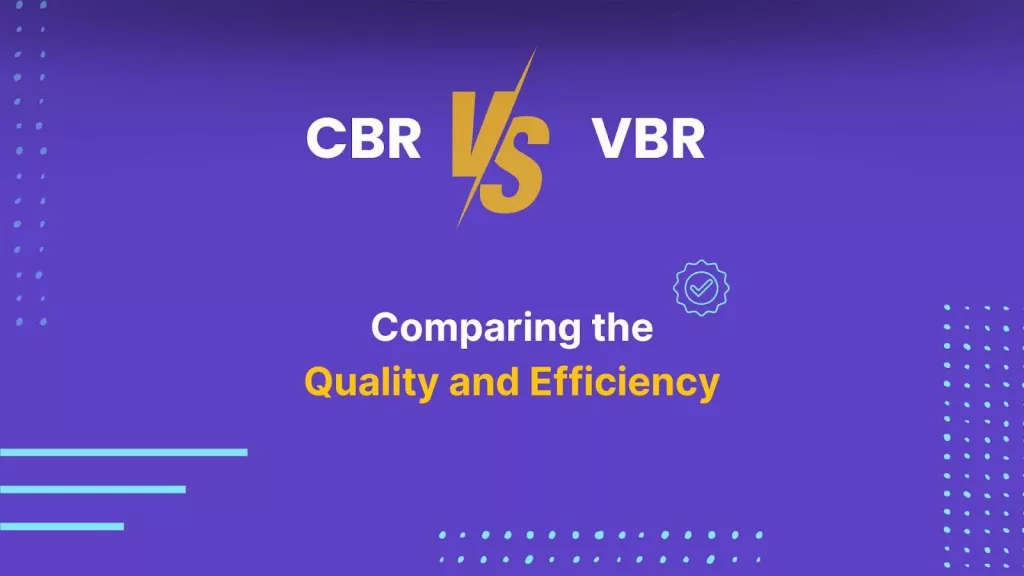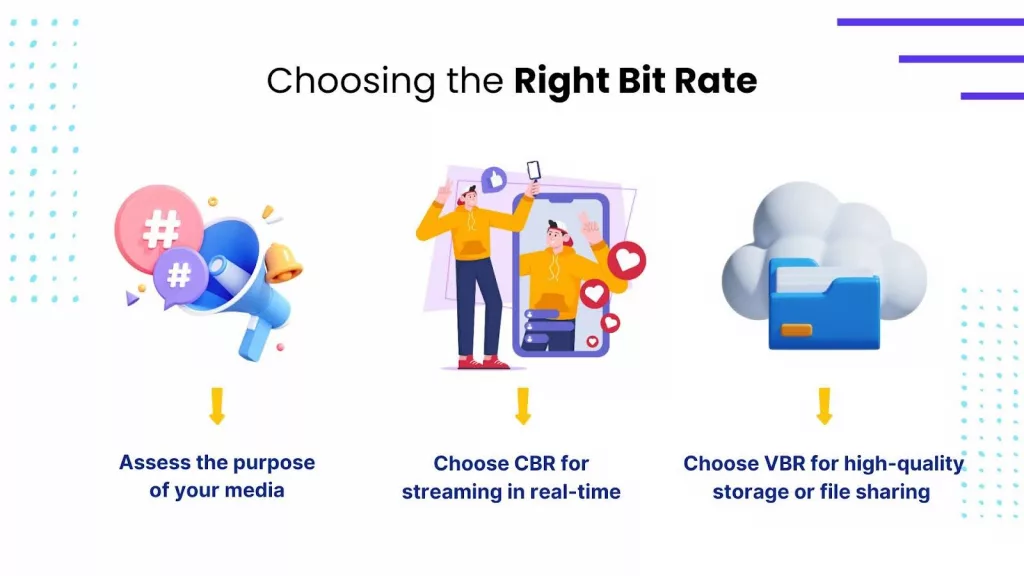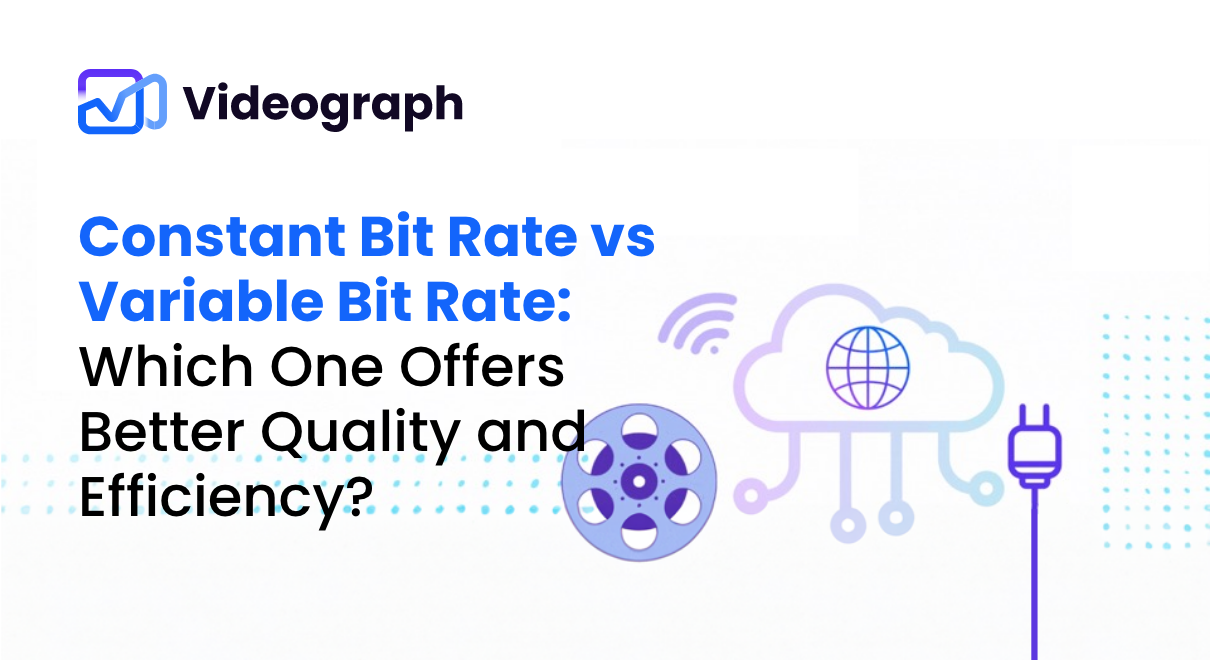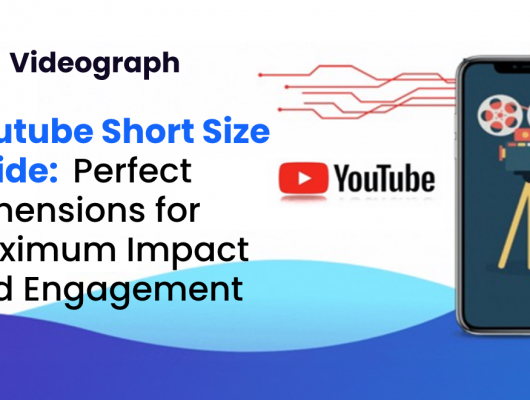The bit rate plays a critical role in determining the quality of audio and video content delivery. Whether you are streaming your favorite movie, listening to music, or creating videos for social media, understanding Constant Bit Rate vs Variable Bit Rate (CBR vs VBR) can significantly impact your experience.
Imagine you are watching a thrilling action movie online, and the picture suddenly becomes blurry. This can happen if the bit rate is not optimized. In this blog piece, let’s discuss bit rates to help you understand how they affect quality and file size.
You will learn what sets CBR and VBR apart, along with their unique benefits and limitations.
So, let’s get going!
Understanding Bit Rates
To kick things off, let us understand the bit rate definition. Bit rate refers to the data processed in a given time, measured in bits per second (bps). In simpler terms, it tells us how much information is transferred every second when you watch a video or listen to audio.
Now, why is this important? The bit rate directly affects both the quality of your media and the size of the files you are dealing with. A higher bit rate usually means better quality, as more data allows for clearer images and richer sounds. However, it also results in bigger file sizes, which can be a concern if you are streaming or have limited storage space.
On the flip side, a lower bit rate can save space but may lead to lower quality, resulting in grainy video or muffled audio. So, when you are creating or consuming content, understanding the impact of bit rate on quality is essential.
Constant Bit Rate (CBR) Explained
CBR encodes audio and video where the bit rate remains constant throughout the entire file. This means the same amount of data is transmitted every second, regardless of the content played. For instance, if you set a video to a CBR of 1,000 kilobits per second (kbps), it will deliver exactly that amount of data each second, whether the scene is action-packed or just a quiet moment.
Constant Bit Rate Benefits
Predictability: Since the bit rate does not change, it is easier to estimate file sizes. This can be useful for streaming applications where a consistent experience is key. For example, if you are uploading a video to a platform with strict file size limits, knowing that your CBR will yield a specific size can help you plan accordingly.
Consistent Quality: With CBR, the audio and video quality remains stable throughout playback, which is important for live broadcasts or scenarios where any fluctuation could be noticeable.
Drawbacks of Constant Bit Rate
Potential for Inefficiency: If a scene does not require much detail, such as a static shot, CBR still uses the same amount of data as it would for a complex action scene. This can lead to larger file sizes without a corresponding increase in quality, which may not be the best use of bandwidth or storage.
Variable Bit Rate (VBR) Explained
VBR is a different approach to encoding audio and video. Unlike CBR, where the bit rate stays the same throughout, VBR adjusts the bit rate based on the content’s complexity.
With VBR, the system analyzes the content in real time. For example, during a quiet scene with little action, the bit rate may be reduced to save data. Conversely, during a sequence with lots of detail, the bit rate increases to maintain quality. This flexibility allows VBR to allocate data more efficiently, depending on what the audience is watching or listening to.
Variable Bit Rate Benefits
Improved Efficiency: It only uses the data necessary for each part of the content, often resulting in smaller file sizes without sacrificing quality. You can enjoy high-quality content while using less bandwidth- perfect for streaming or downloading where speed matters.
Enhanced Quality: VBR can provide better overall sound and picture quality, especially in complex scenes.
Variable Bit Rate Downsides
Unpredictability: Since the bit rate varies, it can be difficult to estimate how large a file will be, which might be a concern if you have storage limits or bandwidth constraints.
Editing or Processing Complications: Some editing software may prefer consistent data rates for smoother performance.
Constant Bit Rate vs Variable Bit Rate: Quality and Efficiency Comparison

CBR vs VBR Quality Comparison
When it is about audio and video quality, CBR offers a consistent experience, which can be reassuring for live broadcasts or situations where any drop in quality would be noticeable. You can enjoy a steady stream of content without fluctuations.
VBR shines in scenarios with a lot of dynamic content. Because it adjusts the bit rate based on what is happening on screen or in the audio, VBR can maintain higher quality during complex scenes while using less data during simpler moments. This means you get an overall richer experience.
File Size and Efficiency of Constant Bit Rate vs Variable Bit Rate
When we talk about efficiency, VBR typically takes the lead. VBR can produce smaller file sizes without compromising quality by varying the bit rate according to the content. This makes it an excellent choice for streaming services where bandwidth is a concern. For example, many music streaming platforms use VBR to deliver high-quality audio while managing the file sizes.
In contrast, CBR can result in larger files because it uses the same amount of data for every second, regardless of whether the scene is busy or still. This predictability in file size can be useful in some scenarios but can lead to wasted data when the content does not require it.
Use Cases
When should you choose CBR over VBR, or vice versa? Here are a few scenarios:
Streaming Services: VBR is often the best bit rate for streaming platforms that prioritize efficiency and quality, especially with varying content.
Live Broadcasts: CBR can be more suitable for live events where consistency is critical, as viewers expect a reliable experience without sudden changes in quality.
File Storage: If you have limited storage and want to maximize quality while minimizing space, VBR is typically the way to go.
Practical Considerations
Now, how do you choose the right method for your specific needs?

Bit Rate Selection Tips
- Assess the Purpose of Your Media: CBR might be suitable for consistent quality if you are dealing with simple audio files or videos. VBR is likely the better option for optimized quality and manageable file sizes for action-packed movies or complex audio tracks.
- Think About Your Audience: When you are streaming live content in real time, use CBR for reliability. For on-demand content, VBR is often preferable for its efficiency and high quality.
- Evaluate Your Storage and Bandwidth: You can choose VBR if you have limited storage or bandwidth but still want to store in high quality and CBR for ample storage and predictable file sizes.
Applications and Tools
Choosing the right bit rate can also depend on your tools. Some popular applications and software can help you set and compare bit rates effectively.
- Audio Editing Software: Programs like Audacity and Adobe Audition allow you to select between CBR and VBR when exporting audio files, helping you achieve the desired quality and size.
- Video Editing Tools: Software like Adobe Premiere Pro and Final Cut Pro offer settings for both CBR and VBR so you can tailor your export settings based on your project needs.
- Streaming Services: Many streaming platforms automatically optimize bit rates based on your internet speed and content type, so they often use VBR for the best user experience.
Real-World Examples and Case Studies
Video Streaming Services: Platforms like Netflix and YouTube use VBR to adjust the bit rate based on the complexity of each scene. This improves visual quality and saves bandwidth, benefiting users with limited internet speed.
Music Streaming: Popular music streaming services like Spotify or Apple Music use VBR to optimize audio quality while minimizing file size. VBR allows for a rich listening experience without consuming excessive data by adjusting the bit rate based on the complexity of the music.
Live Events and Broadcasts: In contrast, live event broadcasts like sports or concerts often use CBR to maintain consistent quality, which is essential for an uninterrupted viewer experience.
Video Production: The choice between CBR and VBR can vary based on the project. For example, a filmmaker may choose CBR for a finalized short film for consistency while opting for VBR for a draft version to reduce file size while maintaining quality.
Conclusion
As we near the end of ‘Constant Bit Rate vs Variable Bit Rate,’ it is clear that both methods have their strengths and pitfalls. CBR offers predictability and consistent quality, while VBR provides greater efficiency and better overall quality, especially for dynamic content like movies and music.
When making the best bit rate choice, consider your content, audience, and available storage and bandwidth to pick the best bit rate method for your project.
FAQs
What is the difference between Constant Bit Rate and Variable Bit Rate?
The main difference lies in how the bit rate is managed. Constant Bit Rate maintains a fixed bit rate throughout the file, resulting in predictable file sizes and consistent quality. Variable Bit Rate adjusts the bit rate based on the complexity of the content, allowing for improved efficiency and better quality in varying scenarios.
Which bit rate is better for streaming?
For streaming, Variable Bit Rate is generally better for high-quality audio and video with minimized data usage. Constant Bit Rate may be preferable for consistent quality in live broadcasts.
How does bit rate affect video quality and file size?
Bit rate directly impacts video quality and file size. Higher bit rates mean better quality but larger file sizes, while lower bit rates can reduce file sizes but may result in lower quality. It is crucial to choose the right bit rate to balance quality and storage needs.







